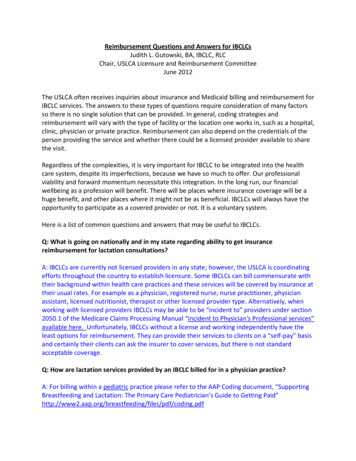
Transcription
Reimbursement Questions and Answers for IBCLCsJudith L. Gutowski, BA, IBCLC, RLCChair, USLCA Licensure and Reimbursement CommitteeJune 2012The USLCA often receives inquiries about insurance and Medicaid billing and reimbursement forIBCLC services. The answers to these types of questions require consideration of many factorsso there is no single solution that can be provided. In general, coding strategies andreimbursement will vary with the type of facility or the location one works in, such as a hospital,clinic, physician or private practice. Reimbursement can also depend on the credentials of theperson providing the service and whether there could be a licensed provider available to sharethe visit.Regardless of the complexities, it is very important for IBCLC to be integrated into the healthcare system, despite its imperfections, because we have so much to offer. Our professionalviability and forward momentum necessitate this integration. In the long run, our financialwellbeing as a profession will benefit. There will be places where insurance coverage will be ahuge benefit, and other places where it might not be as beneficial. IBCLCs will always have theopportunity to participate as a covered provider or not. It is a voluntary system.Here is a list of common questions and answers that may be useful to IBCLCs.Q: What is going on nationally and in my state regarding ability to get insurancereimbursement for lactation consultations?A: IBCLCs are currently not licensed providers in any state; however, the USLCA is coordinatingefforts throughout the country to establish licensure. Some IBCLCs can bill commensurate withtheir background within health care practices and these services will be covered by insurance attheir usual rates. For example as a physician, registered nurse, nurse practitioner, physicianassistant, licensed nutritionist, therapist or other licensed provider type. Alternatively, whenworking with licensed providers IBCLCs may be able to be “incident to” providers under section2050.1 of the Medicare Claims Processing Manual “Incident to Physician's Professional services”available here. Unfortunately, IBCLCs without a license and working independently have theleast options for reimbursement. They can provide their services to clients on a “self-pay” basisand certainly their clients can ask the insurer to cover services, but there is not standardacceptable coverage.Q: How are lactation services provided by an IBCLC billed for in a physician practice?A: For billing within a pediatric practice please refer to the AAP Coding document, “SupportingBreastfeeding and Lactation: The Primary Care Pediatrician’s Guide to Getting /coding.pdf
This gives a number of options for billing for lactation services. The billing specialists within thepractice should be familiar with these codes and procedures and can help to determine what isbest in your situation. However, there is no mechanism for pre-natal billing because you don’thave a pediatric patient yet.Working in an obstetric practice is different. For prenatal visits you are typically going to beeducating (which means you are not providing individual care such as the risk assessmentdescribed above) therefore, might do better with a class billing as S9443. You would first wantto have the billing folks run those codes with the primary insurers in your area to see if they payfor that code. For individual pre-natal visits with an obstetrician your visit might instead be alactation “risk assessment” including review of relevant maternal history, assessment of breastsand nipples and provision of anticipatory guidance regarding lactation. This might be able to bebilled as a visit “shared” with the physician.Generally, the shared visit option seems to work best. If the doctors you are working for are onsite where you see mothers. Your appointments would be part of well or sick visits. The patientwould see the doctor and see you.Q: Can I bill just an RN?A: Billing for the nurse independently is usually coded as “99211” and generally meant to beused for brief visits such as a weight check, allergy shot, or immunization. These are usually 10minutes in length. Therefore, the codes are reimbursed at low rates ( 20) that would notcover the cost of providing an hour or more lactation visit. Your state may have otherguidelines; this will vary with state licensure legislation and state Medicaid regulations.Q: Can I bill as an IBCLC and is there a code book that you would recommend?A: The AAP Coding document cited above, gives CPT codes used by physicians as well thediagnosis codes for these services. However, based on review of the CPT guidance, none ofthese codes appears to specifically describe lactation consultant services. It is unlikely that theE/M codes (99212, 99213, 99214, 99215, 99243, 99244, 99245, 99401, 99402, 99403, 99404,99429) can be used independently by lactation consultants, as the descriptions of these codesare very broad, and lactation consultant services are not defined by state law, meaning thatpayers, such as Medicaid, would be concerned about what service is actually being provided.If none of the existing codes appropriately describe the service, lactation consultant servicescould be reported with, the miscellaneous code S9445 (patient education, not otherwiseclassified, non-physician provider, individual, per session), or unlisted code 99429 (Unlistedpreventive medicine service). However, this would require that the IBCLC educate theircontracting insurer about appropriate billing and reimbursement for services with these codes.Alternatively, lactation consultants could bill for services with S9443, however, rates for S9443
are generally very low (i.e., 20 per service) if they are reimbursed as a covered service bycertain providers.Q: IBCLCs have been invited to become in-network Providers by an insurance group. How dowe do this?A: For private insurers, IBCLCs may be able to be credentialed by a private insurer. The insurerwill determine what qualifications must be met to serve as a lactation provider. Ideally, thiswould be permitted based on the IBCLC certification. Each IBCLC must negotiate a contractbased on meeting the qualifications. This contract would also determine the amount of yourreimbursement. The insurer can choose to assign certain codes to cover your services. Thiswould have to be arranged individually with each provider. Again, this would require that theIBCLC educate their contracting insurer about appropriate billing for “lactation evaluation andmanagement” visits and acceptable reimbursement for these services.Theoretically, this improves your marketability. What the IBCLC must decide is whether theamount that the insurer asks you to accept is financially feasible. If it is not, bargain to see ifthere is any flexibility with them, and if not, the IBCLC either accepts at a loss on the hopes thatyou will increase the client base, or decline to be an in-network provider.What is different for IBCLCs is that insurance companies may not be familiar with our servicesor what we expect in payment, so they may be offering a low rate purposefully or not.Here are some of the things an IBCLC might ask: Will they cover you for the cost of the mother and the baby in the same visit? In thatway, your total reimbursement for a visit is acceptable. What rates are other private clinicians receiving who might have lengthy visits such asthose for lactation, i.e. Physical therapists? Occupational therapists? SpeechPathologists? Is there a limit on the number of visits they will cover? Are they limiting the type of care you can provide in any way? What lactation codes are they accepting? Is there a limit on the age of the baby they will cover? Or the postpartum period for themother? How much time do they think you will spend on the visit? Do they care where you see the patient, or will they only accept care given in a medicalfacility? Can you charge extra for mileage for a home visit?Q: Can an IBCLC be reimbursed by Medicaid?A: For Medicaid reimbursement, all providers must hold a license according to federalregulations; however those holding licenses other than physicians such as RN’s, dieticians,midwives and others are not independently reimbursable in all states. This would have to beresearched within your Medicaid own state regulations. It is also important to consider what
billing codes may be used for various types of providers and what the reimbursement rate is. Itmay not financially feasible for lactation visits to be covered at the usual rates for brief visitssince lactation visits involve two patients are generally much more time intensive than mostprovider visits. Be aware that with Medicaid, lactation counseling will usually fall underpreventive services that must be provided with no cost-sharing to the client so ifreimbursement is low you cannot bill the client for any balance.Medicaid published an Issue Brief on provision of lactation services. It is available ation Services IssueBrief 01102012.pdfQ: Is the IBCLC required to accept whatever the insurance company decides to pay aspayment in full for services?A: This is the collaborative process all providers and insurance companies share. The insureroffers you a payment for being an 'in-network' provider. They want to guarantee that theirclients will not be charged extra. In return, they take away the worry of compensation fromyou. You don't have to involve your client, you communicate with the insurance company.When an IBCLC accepts such a contract with an insurer for reimbursement, they must negotiatethese rates. If the insurer offers a rate that is not acceptable you do not have to accept acontract with that insurer. The rates or reimbursement and eligibility co-pays or co-insurancemay be different based on certain variables such as:Initial versus follow-up visitsHome, in-patient or out-patient settingsPreventive (well) visits versus sick visitsQ: If the insurer / Medicaid “patient benefit” requires no deductible, no co pay, nocoinsurance, no out of pocket anything for the client / patient, can the IBCLC ask the client /patient to pay the balance?A: If the services are not “coded” as preventive care, then a co-payment may be allowed. Underthe current laws of the Affordable Care Act (ACA), preventive services are required to have nocost-sharing to the patient so the IBCLC cannot ask for any further payments from the client.This may change if the ACA is repealed.Q: What are the billing codes for lactation services?A: The Healthcare Common Procedure Coding System (HCPCS) coding system utilized by theMedicaid program is comprised of two parts.Level I is the Current Procedural Terminology (CPT),[1] maintained by the American MedicalAssociation (AMA), and Level II is the HCPCS national code set, maintained by the Centers forMedicare & Medicaid Services (CMS).
The CPT and HCPCS codes that may be relevant to lactation consultant services are included inthe following table. However, none of these codes seems to adequately account for thedescription, time involved and nature of a lactation visit.In light of these limitations with respect to the existing CPT codes, USLCA has applied for a newHCPCS code to describe lactation consultant services, “lactation evaluation and management”.This code would be “per 15 minutes” so the units would be added to equal the time it takes todo the visit, typically 1-2 hours. The next step after obtaining a code is to work for appropriatereimbursement for that time spent by an IBCLC for the visit. We are awaiting response to ourapplication and will inform IBCLCs if / when such a relevant code becomes available.CPT 780498960989619896299212DescriptionLactation Classes, Non-Physician Provider, Per SessionHealth and Behavior Assessment (eg, Health-Focused Clinical Interview, BehavioralObservations, Psychophysiological Monitoring, Health-Oriented Questionnaires),each 15 minutes face-to-face with the patient; initial assessmentHealth and Behavior Assessment (eg, Health-Focused Clinical Interview, BehavioralObservations, Psychophysiological Monitoring, Health-Oriented Questionnaires),each 15 minutes face-to-face with the patient; re-assessmentHealth and Behavior Intervention, Each 15 Minutes, face-to-face; IndividualHealth and Behavior Intervention, Each 15 Minutes, face-to-face; GroupHealth and Behavior Intervention, Each 15 Minutes, face-to-face; Family (With thePatient Present)Health and Behavior Intervention, Each 15 Minutes, face-to-face; Family (Withoutthe Patient Present)Medical Nutrition Therapy; Initial Assessment and Intervention, Individual, Face-toFace with the Patient, each 15 minutesMedical Nutrition Therapy; Re-Assessment and Intervention, Individual, Face-toFace with the Patient, each 15 minutesMedical Nutrition Therapy; Group (2 or more individual(s)), each 30 minutesEducation And Training For Patient Self-Management By A Qualified, NonphysicianHealth Care Professional Using A Standardized Curriculum, Face-To-Face With ThePatient (Could Include Caregiver/Family) Each 30 Minutes; Individual PatientEducation And Training For Patient Self-Management By A Qualified, NonphysicianHealth Care Professional Using A Standardized Curriculum, Face-To-Face With ThePatient (Could Include Caregiver/Family) Each 30 Minutes; 2-4 PatientsEducation And Training For Patient Self-Management By A Qualified, NonphysicianHealth Care Professional Using A Standardized Curriculum, Face-To-Face With ThePatient (Could Include Caregiver/Family) Each 30 Minutes; 5-8 PatientsOffice Or Other Outpatient Visit For The Evaluation And Management Of AnEstablished Patient, Which Requires At Least 2 Of These 3 Key Components: AProblem Focused History; A Problem Focused Examination; StraightforwardMedical Decision Making. Counseling And/Or Coordination Of Care With OtherProviders Or Agencies Are Provided Consistent With The Nature Of The Problem(s)
992139921499215992439924499245And The Patients And/Or Familys Needs. Usually, The Presenting Problem(s) AreSelf Limited Or Minor. Physicians Typically Spend 10 Minutes Face-To-Face WithThe Patient And/Or Family.Office Or Other Outpatient Visit For The Evaluation And Management Of AnEstablished Patient, Which Requires At Least 2 Of These 3 Key Components: AnExpanded Problem Focused History; An Expanded Problem Focused Examination;Medical Decision Making Of Low Complexity. Counseling And Coordination Of CareWith Other Providers Or Agencies Are Provided Consistent With The Nature Of TheProblem(s) And The Patients And/Or Familys Needs. Usually, The PresentingProblem(s) Are Of Low To Moderate Severity. Physicians Typically Spend 15Minutes Face-To-Face With The Patient And/Or Family.Office Or Other Outpatient Visit For The Evaluation And Management Of AnEstablished Patient, Which Requires At Least 2 Of These 3 Key Components: ADetailed History; A Detailed Examination; Medical Decision Making Of ModerateComplexity. Counseling And/Or Coordination Of Care With Other Providers OrAgencies Are Provided Consistent With The Nature Of The Problem(s) And ThePatients And/Or Familys Needs. Usually, The Presenting Problem(s) Are OfModerate To High Severity. Physicians Typically Spend 25 Minutes Face-To-FaceWith The Patient And/Or Family.Office Or Other Outpatient Visit For The Evaluation And Management Of AnEstablished Patient, Which Requires At Least 2 Of These 3 Key Components: AComprehensive History; A Comprehensive Examination; Medical Decision MakingOf High Complexity. Counseling And/Or Coordination Of Care With Other ProvidersOr Agencies Are Provided Consistent With The Nature Of The Problem(s) And ThePatients And/Or Familys Needs. Usually, The Presenting Problem(s) Are OfModerate To High Severity. Physicians Typically Spend 40 Minutes Face-To-FaceWith The Patient And/Or Family.Office Consultation For A New Or Established Patient, Which Requires These 3 KeyComponents: A Detailed History; A Detailed Examination; And Medical DecisionMaking Of Low Complexity. Counseling And/Or Coordination Of Care With OtherProviders Or Agencies Are Provided Consistent With The Nature Of The Problem(s)And The Patients And/Or Familys Needs. Usually, The Presenting Problem(s) Are OfModerate Severity. Physicians Typically Spend 40 Minutes Face-To-Face With ThePatient And/Or Family.Office Consultation For A New Or Established Patient, Which Requires These 3 KeyComponents: A Comprehensive History; A Comprehensive Examination; AndMedical Decision Making Of Moderate Complexity. Counseling And/OrCoordination Of Care With Other Providers Or Agencies Are Provided ConsistentWith The Nature Of The Problem(s) And The Patients And/Or Familys Needs.Usually, The Presenting Problem(s) Are Of Moderate To High Severity. PhysiciansTypically Spend 60 Minutes Face-To-Face With The Patient And/Or Family.Office Consultation For A New Or Established Patient, Which Requires These 3 KeyComponents: A Comprehensive History; A Comprehensive Examination; And
994019940299403994049942998960Medical Decision Making Of High Complexity. Counseling And/Or Coordination OfCare With Other Providers Or Agencies Are Provided Consistent With The NatureOf The Problem(s) And The Patients And/Or Familys Needs. Usually, The PresentingProblem(s) Are Of Moderate To High Severity. Physicians Typically Spend 80Minutes Face-To-Face With The Patient And/Or Family.Preventive Medicine Counseling and/or risk factor reduction intervention(s)provided to an individual (separate procedure); approximately 15 minutesPreventive Medicine Counseling and/or risk factor reduction intervention(s)provided to an individual (separate procedure); approximately 30 minutesPreventive Medicine Counseling and/or risk factor reduction intervention(s)provided to an individual (separate procedure); approximately 45 minutesPreventive Medicine Counseling and/or risk factor reduction intervention(s)provided to an individual (separate procedure); approximately 60 minutesUnlisted Preventive Medicine ServiceEducation and training for patient self-management by a qualified, non-physicianhealth care professional using a standardized curriculum,face-to-face with the patient (could include caregiver/family) each 30 minutes;individual patientQ: Can I order the Reimbursement Toolkit from USLCA?A: The Reimbursement Toolkit is currently unavailable. We will be revising this in the nearfuture. Pat Lindsay offers a tool kit on her website available at: http://patlc.com/LVR/
Alternatively, lactation consultants could bill for services with S9443, however, rates for S9443 . are generally very low (i.e., 20 per service) if they are reimbursed as a covered service by . billing codes may be used for various



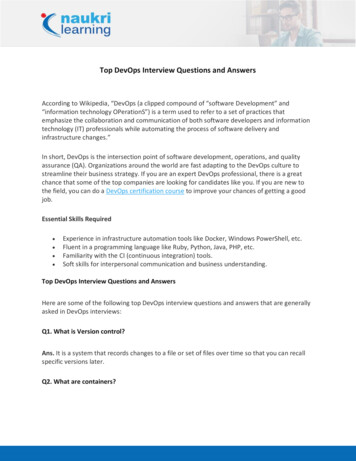
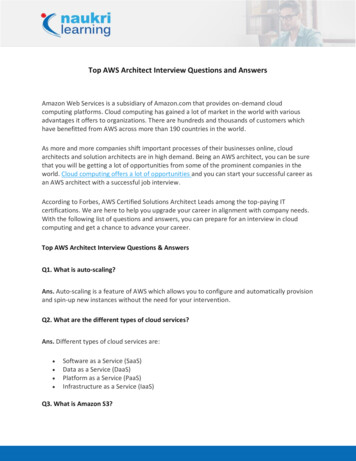
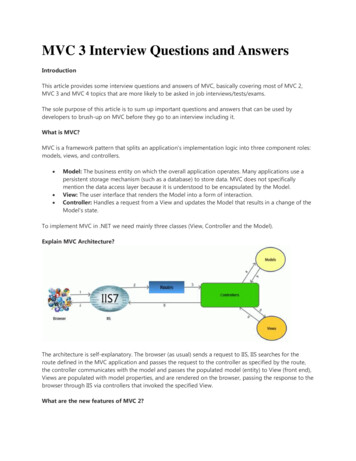
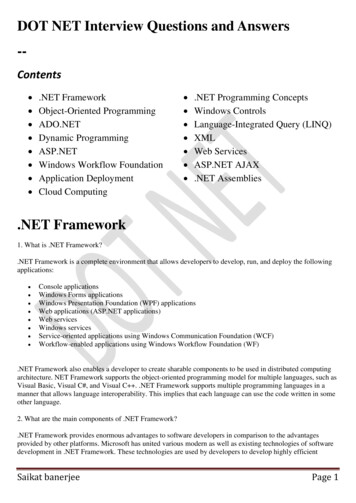




![Informatica Interview Questions and Answers [Scenario-Based]](/img/2/informatica-interview-questions-and-answers-scenario-based-1.jpg)